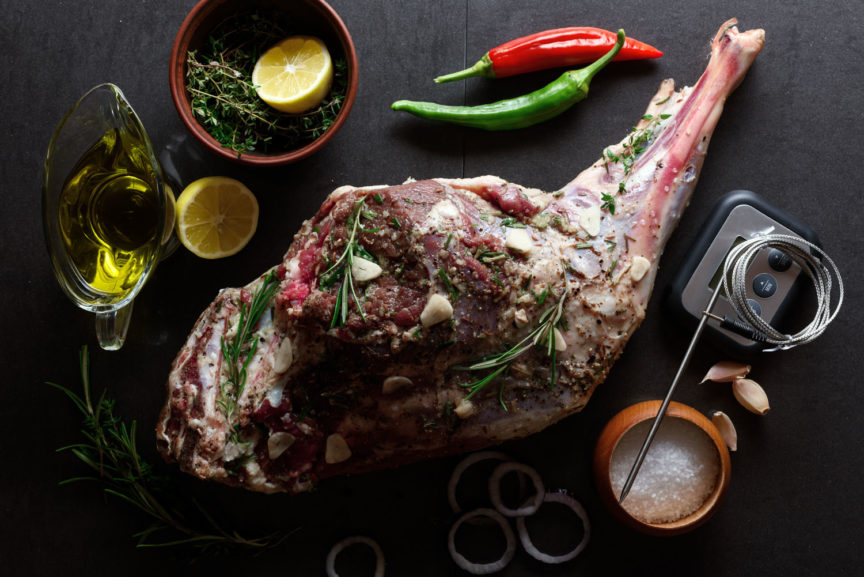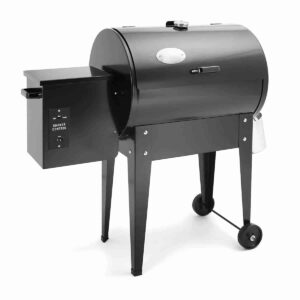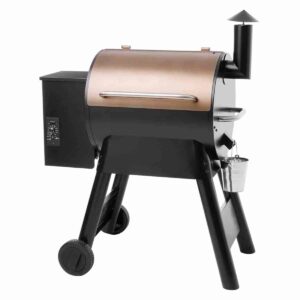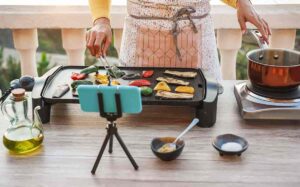Human beings have been cooking meat for more than 250,000 years.
Cooking procedures that use dry heat are some of the oldest methods of preparing meat. Grilling is known to produce some of the most attractive and tastiest pieces of barbecue.
There is more involved in preparing a barbeque beside placing cuts of steak on a hot grill. You must master the correct bbq temperature for grilling various types of meat. Every griller desires to have the meat tender, delicious, and free of pathogens.
For best results, you must control the bbq temperature and cook the meat for a given period. It calls for an understanding of the changes that meat undergoes when subjected to different temperatures during the grilling process.
If you experience trouble with regulating heat when grilling your meats, you have come to the right place. Below is a guide for getting your BBQ temperature right.
Keep on reading to learn more!
Preparing the Charcoal Grill
Heating your charcoal grill begins with a chimney starter. Chimney starters are inexpensive installations that allow you to create a fire in a controlled way.
The chimney can get extremely hot, so you should put it on a heat-proof surface before lighting the fire. Next, stuff some papers in the chimney and fill the stove with charcoal. Light the papers at the base and let the charcoal smolder for about 15 minutes.
The duration will be sufficient for the charcoal to catch fire and stop producing smoke. Place enough charcoal below the grill and replace the grate if necessary.
Coals require oxygen to burn, and it gets hotter for as long as they remain exposed to air. To increase the BBQ temperature, open the bottom vents and don’t cover the grill.
To reduce the heat, open the bottom vents partially to control air circulation in the stove. Keeping the vents wide open makes the temperature too high due to an excessive oxygen supply. On the other hand, closing them can lead to smoking.
It’s advisable to keep the bottom and upper vents half to three-quarters way open to attain a desirable BBQ temperature.
Getting the Gas Grill Ready
If you are to use a gas grill, set the desired heat level and let the grill heat for 15 minutes with the lid in place. Shutting the cover allows the grill to hold in the heat better than when open. Controlling the heat level with knobs is rather straight-forward.
If your grill has multiple burners, say eight, put some on medium heat, others on high, and leave some off. The combination will present you with many heat areas to manipulate your barbecue.
Estimating the Grill Temperature
Regardless of the type of grill you are using, it’s vital to determine the optimal BBQ temperature before grilling your meat. Experienced grillers sometimes perform a hand test. They place a hand over the heat and approximate the temperature based on the duration they can withstand the heat.
A more accurate and safer method of determining the BBQ temperature is using a meat thermometer. You can set its probe as close to the grill as possible around the grilling area.
If you have to use the hand test, here is what to expect.
Medium-Low Heat
The time limit for the hand test for medium-low heat is 7-10 seconds. The temperature is around 325 °F. The heat is suitable for the gentle cooking of soft foods like sausages without making them burst.
Medium Heat
For meats like bone-in chicken that require longer to cook, a temperature of about 350 °F is desirable. The interior of the food cooks to tenderness without destroying the exterior. You would need 6-7 seconds to determine the BBQ temperature with the hand test.
Medium-High Heat
The hand test takes about 4-5 seconds to estimate temperatures between 375 °F and 450 °F. Medium-high heat is ideal for preparing foods like vegetable kebabs with soft interior or burgers with browned crusts.
High Heat
With temperatures between 450 °F and 650 °F, high heat is suitable for foods that cook quickly with frequent turning. The temperature adds remarkable detail like color to steaks, cooking them in a few minutes. It takes 1-2 seconds to approximate high heat with the hand test.
Changes Observed at Various Temperatures
You should understand what happens to meat during the grilling process. Different germs die at various temperatures while the meat assumes new color and flavor. Therefore, you must know when it’s safe to conclude the cooking process.
Low Heat
The best barbecues result from grilling the meat at low temperature for an extended period. Below is what transpires at low heat.
At about 95 °F, animal fat starts to soften. Fish protein begins to get denatured at 104 °F, but it is not safe for consumption since bacteria remain alive. The reason for fish fillet being so delicate is that a lot of the meat comprises of soft connective tissue.
Listeria monocytogene, a bacteria that can cause death cannot reproduce at temperatures beyond 113 ºF. Myofibrillar proteins start to breakdown at 114 °F. These are the proteins that constitute the grain of meat that makes it tough.
By the time the heat reaches 126 ºF, any bacterium that you should worry about can no longer reproduce. However, the temperature won’t kill the existing ones.
Most pathogens begin to die at 130 ºF. Animal fat also changes into liquid. If you are to grill at this BBQ temperature, ensure that you cook the meat for at least two hours. Most dangerous bacteria die within 37 minutes at 135 ºF.
If you are grilling chicken, you need to cook it for 82 minutes at 136 ºF to ensure safety. By adjusting the heat to 140 ºF, poultry gets ready in only 35 minutes.
You wipe out all listeria within 17 minutes when your meat cooks at 145 ºF. The temperature also keeps the meat dry on the outside but juicy in the interior. You can still have a crispy surface without having to dry the meat.
Collagen gets denatured into tasty gelatin starting from about 154 ºF. Most bacteria die within 30 seconds when subjected to 155 ºF. More stubborn strains like some in poultry require about two minutes.
You get a well-done piece of steak at 165 ºF. You can grill your meat at this temperature without burning it.
Listeria will die within no time if you barbecue your steak at 185 ºF. If you want to grill potatoes with crispy skin, 210 ºF is an ideal BBQ temperature.
Medium Heat
After killing all the pathogens with low heat, medium heat adds flavor to your barbeque. Water evaporates at 212 ºF since it cannot get any hotter beyond this temperature.
If you are cooking at 225 ºF, divide the grill into two zones. Shove the coals into one end for extreme heating and leave the other corner empty for ambient temperature. The heat is tolerable, and proteins don’t shrink too much.
At this temperature, the rate of cooling of the meat by evaporation is equal to the speed of warming by convection. The meat maintains a constant temperature until the surface dries up so that there is no more evaporation. The phenomenon is prominent in grills with minimal airflow or in humid conditions.
Sugar and amino acids blend well from 310 ºF to create fantastic flavors. Thermal decompositioncreates a film of proteins known as the pellicle on the surface of the meat.
As with the 225 ºF, 325 ºF is another ideal temperature for practicing the two grilling zone method. You can make your chicken skin crispy or turn the color of the surface of your steak into dark brown if desired.
High Heat
Grilling at high BBQ temperature requires utmost concentration. You can turn everything into charcoal if you aren’t quick. At 570 ºF, the barbeque emits a mixture of gases including carbon monoxide, carbon dioxide, and different oxides of nitrogen.
A reaction of carbon monoxide and nitric oxide with myoglobin gives the meat an appealing pinkish color.
Smoke in barbequing is a vital ingredient for adding flavor to the meat. The best grilling smoke is blue. It has few impurities and produces less char while making your barbeque tastier.
Soft charcoals burn at 716 ºF. Some varieties can heat up to more than 900 ºF. However, you may have to use a substantial amount of coal to sustain such BBQ temperature.
Be careful if you attain 1000 ºF. If you are using a thermometer, it can blow at this temperature. Whatever you are grilling, you have to flip it like every minute, or it all burns up.
BBQ Temperature - Wrap Up
If you know the correct BBQ temperature for grilling various meats, making a delicious and tender barbecue should not be an issue. The problem comes in maintaining the desired amount of heat.
Fortunately, you can eliminate matters of undercooking or overcooking with an instant-read thermometer.
Irrespective of the type of meat you are grilling, don’t cut into it to check how the interior is cooking. Doing so can dry the meat out or ruin your presentation. Know the amount of time necessary and regulate the temperature accordingly.
Do you still have concerns about attaining the perfect BBQ temperature? Visit our site today for practical grilling tips.
Check out our Recent Posts
Z Grills Review
If you’re looking for a grill that will last, Z Grills is the way to go. Z grills are made of the best quality materials...
Read MorePit Boss Pellet Grill Review
Pit Boss is one of many when it comes to manufacturers of wood pellet grills and smokers. If you have spent any amount of time...
Read More10 Fun Benefits of Taking an Online Cooking Class
There’s never been a better time to take an online cooking class. With the continued popularity of online learning, there are more and more exciting...
Read More



